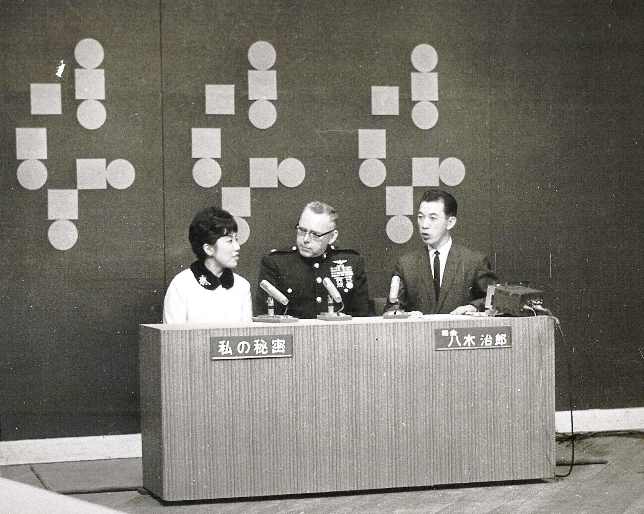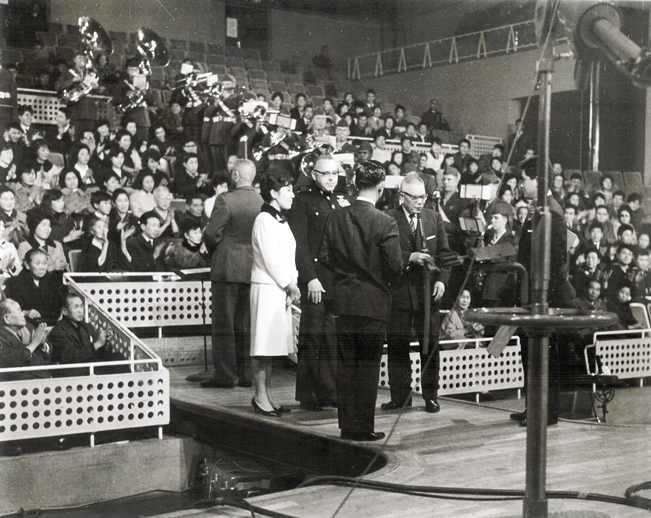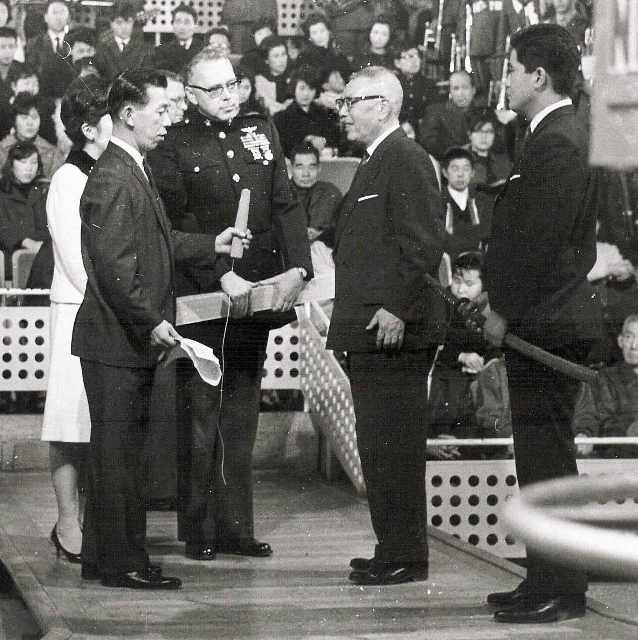|
|
|
|
|
|
|
by Dean S. Hartley, Jr.
21 January 1965
Dear Bob,
First, of course, I wish to congratulate you and the other new officers on your election. Then, naturally, I'd like to commend all the members for their contributions to what seems (to me, out here) to have been a highly successful year in 1964. I am sorry I was not able to contribute more, but the talks and papers which have been presented have made the Token Kai a really meaningful organization - and one which I have been talking up with a great deal of enthusiasm (and success) throughout Japan. Lastly, I wish to express my appreciation to the members for renewing my membership after I had forgetfully allowed myself to become delinquent. Although I don't know where I'll be sent when I return from Japan about the middle of June, I am certainly looking forward to attending the next meeting after I do return.
This letter is for the general information of the membership, and is addressed to them through you and I thought a few of the others might be interested in some of the experiences I have had since I got here. I might add that these have not been as extensive as I had hoped, up until now, because I have not had a fully trained staff until recently. As of a few days ago, when we submitted our annual budget after about two weeks of the most concentrated effort, all of my staff are fully trained, and I can go flying more, as well as visit some of the places and people I have missed so far. As a short resume, I submit the following:
(1) Sometime in July '64, I visited the Ide's (father and son) in Okayama, and took two of my swords for polish - one a tachi signed Masazane and the other a shorter blade, signed Koretomo. I believed both of these to be Ko-Bizen - more later on this. Unfortunately I had only parts of two days and did not get to visit Dr. Torigoye, but I will accomplish that on a longer visit soon.
|
|
|
|
|
|
|
I did have an opportunity to visit Osafune's sole remaining sword-smith, Imaizumi Toshimitsu, one of whose blades is owned by Bob Haynes. While there, two separate sword societies came to visit him, and with Ide Masahiro's assistance, we had a fairly lengthy and interesting conversation. After the talking, Toshimitsu San took us all to his forge and demonstrated various steps and techniques (dressed in his ceremonial robes), and allowed us an opportunity to take some pictures. Enclosed are some negatives which might be of interest. The polishing of my two swords is still not finished.
|
|
|
|
|
|
|
|
|
|
|
|
(2) On a subsequent official visit to Yokosuka, I was able to steal a day and a half, during which I visited an antique dealer in Motemachi St., as well as make a quick trip through Kamakura, where I stopped at the largest sword and armor shop, and an even briefer visit to a small shop in Zushi, where they had for sale a certified dolmen sword with Tsuba (no saya or mounts) - for about Y36,000 ($100). I didn't buy anything at either of the two latter places. I was short of cash, naturally. Back to Okuyama Tokutaro San in Motomachi St.: Having been introduced by a very old friend of his, and having established my bonafide by revealing my affiliation with the Token Kai, and after lengthy conversation in which his son acted as interpreter, I was granted a treat which I believe to be rare even to Japanese. Okuyama San went into his private quarters and brought out a large leather locker, which when opened, revealed about 150 swords. I think I further solidified my position by identifying the first sword he handed me as Tegai Kaneyoshi, which is exactly what the Green Paper said it was. I spent the next two hours (all I had) engrossed in the examination of about 20 of the swords. Among those I examined were blades by Go Yoshihiro (not signed, but with a Honnami Sayagaki), a Sa (signed), a Kotetsu (signed, certified, and having a name - which I recognized but can't remember now. I have also seen a photograph of it in a book - it was immediately recognizable). There was also a Shinkai, a Nobukuni tanto, and several other first level blades, as well as five or six really fantastic mounts, mostly court tachi. Some of these had documents relating them to various Shoguns and famous people. I did not have a chance to make oshigata, but have been invited to return and take my time examining and taking rubbings of any or all of the blades.
The really intriguing fact is that the existence of this collection, to say nothing of its extent and value, is to the best knowledge of Okuyama San, virtually unsuspected anywhere in Japan. He is what might be called a "closet collector." He enjoys his really unbelievable store of art objects in all fields (a Kenzan bowl and box valued at Y3,000,000 for example) and sells his antiques only as a means of improving his collection. His best items can only be bought by people who personally please him.
(3) While I was stationed in Washington, DC, in 1957, I bought a sword in a Kyu Gunto mount. There was a badly eroded signature and date on the Nakago which I finally deciphered to be Bishu Osafune Ju Nin / Nagamitsu Saku and Shoo Gan Nen, etc. (1288). A couple of years later I happened to slide the wooden inserts out of the leather sheath and discovered an inscription which read Gunto Chujo (Lt. General) Nemoto Hiroshi, showa 18, New Year's day, plus a description of the blade and repetition of the tang inscription. Many of you have seen and examined this blade and have formed some pretty sound opinions of its authenticity. While still in the states I made sporadic attempts to find out about General Nemoto, but with no luck. With the same idea in mind, I brought the sword with me to Japan, and within a couple of months found him referred to in a book about WWII (KOGUN), written by a Japanese colonel. It happened that at the end of WWII he was based in Kalgan, Mongolia as Commander, North China Garrison Forces. With the assistance of the local Japanese Air Self Defense Force Commander and the Demobilization Office in Tokyo, we located the General. He is now 73 years old and lives with his son in Machido City just to the west of Tokyo. He is in excellent health, in complete possession of all his facilities, and a very dignified and impressive old gentleman. He was graduate #23 from the Imperial Military Academy and had obviously been an individual of some stature before WWII.
Without my knowledge, the JASDF PIO set up the return of the sword on a national TV show, and also informed the general of this. They also elicited the information that, upon his delayed return to Japan, one of his staff had approached him for some assistance in obtaining food and clothing for his family, and since General Nemoto had no money, he gave him the sword to sell. This Mr. Kimura (since dead) apparently did, and I ended up with it several years later. To bring this to a head, on 21 Dec, I did appear on a nationwide TV panel show (in color - full blues with gauds) called "Watashi no Himitsu" or "My Secret." I was accompanied by the entire 1st Marine Aircraft Wing Band which played the fanfare - and then Christmas Carols after the return of the sword. I had not met the general until he appeared on stage to receive the sword. He was accompanied by his son who was carrying a long box of some kind. Oh yes - the panel guessed my secret, including the town (Osafune) in which the blade was made, but not the maker. The long box contained a famous (in Japan) kakejiku by Koka Murayama, an "examiner" in the Imperial Academy of Arts (he has been dead several years). The name of the scroll is Ko Mon (Tiger Gate), and this the general presented to me in return. Afterwards we had a most interesting conversation for about an hour.
 "Watashi no Himitsu" or "My Secret" |
 Presentation of sword to General Nemoto |
 Presentation of scroll to Col Hartley |
 1st Marine Air Wing Band |
 The scroll: Ko Mon, Tiger Gate |
|
The next day, even though in civilian clothes, I was recognized by bell-boys, sales girls and shop proprietors in a variety of locations in Tokyo. Many of them said "Domo arigato gozaimasu" or "Thanks for returning the sword." Similarly, when I returned to Iwakuni, I received cards and personal thanks from many people as well as editorial comments in newspapers. It was a very satisfying climax to a fairly lengthy search.
(4) The morning after the TV show, I was visited in my hotel (for about two hours, all the time I had) by Dr. Junji Homma and Mr. Junzo Sato. We had a very pleasant conversation, examined some of my blades and Dr. Homma looked over the oshigata of my collection. There were some quite illuminating observations (for me, at any rate). Dr. Homma is in the final stages of preparing a book on Hizen blades, and in looking at the rubbings and descriptions of my blades came across one of a Munetsugu which most of us had thought at best to be Nidai. He apparently thought differently and requested that I bring it to him as soon as the polisher (where it is now) is finished, so that he can examine it closely, and if it is as he thinks, photograph it for inclusion in his book - and give me an official appraisal of it.
Further, in examining a tanto with sayagaki attributing it to late Soshu (in other documents attributed specifically to Soshu Hiromitsu f Eisho - 1500) he immediately recognized the sayagaki as by his own teacher (Higa Imamura Choga), and the blade as being probably from the Yamanouchi (Daimio of Tosa) collection, into which his teacher's collection went when he died. He was quite surprised that a blade of this quality and from this source was even available outside personally negotiated channels. He also said his master's appraisals were very rare.
Another blade he examined has been pretty strongly negotiated for by Joe Bott (with no luck) and others, although none of us knew what it was. He attributed this particular blade to Oishi Sa, and stated it was very fine. In other instances, he unhesitatingly identified my long Masazane Tachi, which most folks thought to be Yamato or Sengo (1500s) as Ko-Bizen, and wants to examine it more closely when the polisher is finished. More of the same, but it all contributed to a most gratifying two days in Tokyo. I have been invited back for a longer and more detailed visit, and have also been introduced (by phone from Dr. Homma) to Mr. Yokota, the only qualified appraiser and member of the committee in Hiroshima. Now that my budget is in, I intend to take full advantage of all such opportunities.
(5) General information - The Japanese are now pretty affluent, and are more and more interested in reviving their respect and appreciation for their cultural heritage. Since the sword is such an integral part of their history, they have become avid collectors. Even in the time I have been here I have seen the going price of swords double or treble. In Inami's shop I witnessed a business man walk in off the street, look around for about fifteen minutes and peel off Y150,000 ($417.00) for a tachi-mounted Sukesada that I had already examined carefully. I assure you that I have turned down better blades because the price was more than $35.00, although the mounts were pretty nice. The blade was mediocre Sukesada, with all the typical flows found in blades so signed (excepting of course the few first rank ones). Tsuba may occasionally be found at reasonable (or rarely, at bargain) rates, but they approximate state-side prices. Pole arms and arrowheads are practically not to be seen. Armor goes for $200.00 for the most recent style and up to "you wouldn't believe it." Kabuto alone are even higher, if they are any good. Kozuka, Kogai, Fuchi/Kashira, all are high, comparable to U.S. prices. Good Makiye lacquer is fantastically high, as are Inro and netsuke. All are getting scarcer and more expensive daily.
Having made the general statements above, I must add that I do have some friends and connections who beat the bushes in out-of-the-way locations and come up with some pretty good bargains on occasion. This is beginning to play out too, though, and I must say that except for polishing, appraisal, and specialized items such as handle braid, etc., the best hunting grounds are back there. Naturally, the "looking" can be pretty good here if you are fortunate enough to meet the right people.
That just about concludes my report up to now. I do have every hope that I may have more of general interest in the future such as first hand reports on forging, tempering, polishing, [...missing line...] appraisal. I even hope for some kind of photo report, but have no positive plans on this. Until the next report - or I get back, the best to all of you.
Dean Hartley
P.S. Am enclosing some photo's of the My Secret show and a copy of Stars and Stripes (page 7). Keep these if you like.
Website created by Dean S. Hartley III.